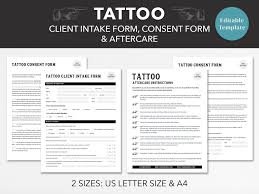Introduction to Tattoo Consent Forms
Tattooing has become a mainstream form of body art, with people opting for tattoos for various reasons—whether for self-expression, cultural significance, or simply as an aesthetic choice. Before you get your tattoo, however, there is one crucial step that you must complete: signing a tattoo consent form. A tattoo consent form is a legal document that ensures you understand the risks, responsibilities, and necessary information before the tattoo procedure begins. It also protects both the tattoo artist and the client by outlining the terms of the agreement.
The importance of this document cannot be overstated, as it serves as a binding agreement between the tattoo artist and the client. It details the terms of the tattoo procedure, including the scope of the tattoo, the risks involved, and the responsibilities of both parties. This guide provides an in-depth understanding of tattoo consent forms, why they are essential, and what you can expect from this important document.
What is a Tattoo Consent Form?
A tattoo consent form is a written document that a client must sign before getting a tattoo. The form includes various sections that outline critical information related to the tattoo process. It serves as a declaration from the client stating that they are aware of the potential risks associated with tattooing, have disclosed any medical conditions, and consent to the tattoo procedure being carried out.
By signing the consent form, the client confirms that they are of legal age to get a tattoo (which varies by location), have no medical conditions that would hinder the procedure, and agree to follow the tattoo artist’s aftercare instructions. The form also acts as a liability waiver, ensuring that the tattoo artist and the studio are not held responsible for any adverse reactions, infections, or complications arising from the tattoo.
Why Are Tattoo Consent Forms Important?
1. Legal Protection for the Artist and Client
Tattoo consent forms provide legal protection for both parties. For the artist, the form serves as a record that the client was informed about the risks and agreed to the terms before the tattooing process began. In case of any legal disputes or complications, the form acts as evidence that the artist followed the necessary steps to ensure the client’s safety and consent.
For the client, the form provides assurance that the tattoo artist is following all safety protocols and legal requirements, such as using sterile equipment and adhering to hygiene standards. The consent form is also an acknowledgment that the client is not under the influence of alcohol or drugs, which could impair their judgment.
2. Ensuring Client Safety
Tattooing involves the use of needles and ink, which can carry risks such as allergic reactions, infections, or scarring. The consent form helps ensure that the client is aware of these potential risks and agrees to proceed despite them. It also allows the tattoo artist to gather vital medical information that could impact the client’s safety, such as allergies, skin conditions, or blood disorders.
For example, a person with a history of keloid scars or a weakened immune system may need special considerations or may be advised against getting a tattoo altogether. The consent form helps ensure that such information is disclosed and considered before the tattooing begins.
3. Informing Clients About Aftercare
Another key purpose of the tattoo consent form is to inform clients about the aftercare process. After getting a tattoo, proper care is essential to avoid infections, scarring, and fading. The consent form often includes instructions on how to take care of the tattoo during the healing process, such as avoiding certain activities, using recommended ointments, and cleaning the tattoo properly.
By signing the form, the client acknowledges that they have received aftercare instructions and understand the importance of following them to ensure the tattoo heals properly.
Key Components of a Tattoo Consent Form
A tattoo consent form typically includes several important sections that must be filled out by the client. While the specifics of the form may vary from one tattoo studio to another, here are the common components that most tattoo consent forms will include:
1. Personal Information
This section collects essential details about the client, such as their full name, address, phone number, and date of birth. The form will also include a section confirming the client is of legal age to receive a tattoo, which varies by jurisdiction. In some areas, individuals under the age of 18 may require parental consent to get a tattoo.
2. Medical History
The medical history section is one of the most critical parts of the tattoo consent form. It asks the client to disclose any medical conditions, allergies, or medications that may affect the tattoo procedure. This includes conditions like skin disorders (e.g., eczema, psoriasis), blood disorders (e.g., hemophilia), immune system issues, or any history of allergic reactions to tattoo ink.
This section is crucial for the tattoo artist to ensure that the procedure is safe for the client. If the client has any medical concerns that may hinder the tattooing process, the artist may suggest postponing the tattoo or recommend seeking medical advice before proceeding.
3. Acknowledgment of Risks
This section of the consent form outlines the potential risks and complications of tattooing. It typically includes information on possible allergic reactions, infection, scarring, and pain. By signing this section, the client acknowledges that they are aware of the risks and are choosing to proceed with the tattooing process voluntarily.
Tattoo artists will also inform clients about the possibility of dissatisfaction with the final result, as well as the risk of skin irritation or other reactions. The acknowledgment of risks section ensures that the client fully understands these potential outcomes and is comfortable moving forward.
4. Consent to the Procedure
The main purpose of the tattoo consent form is for the client to give informed consent to the tattoo procedure. This section confirms that the client agrees to the tattoo being performed, understands the nature of the tattoo, and gives the artist permission to proceed with the design. It may also specify the area of the body being tattooed and the approximate size of the design.
5. Aftercare Instructions
Tattoo aftercare is vital for the healing process, and many tattoo consent forms include a detailed section outlining the steps the client should take post-tattoo. This may include guidelines on how to clean the tattoo, when to apply ointments or lotions, and how to avoid potential complications such as infection or fading.
6. Liability Waiver
The liability waiver section is one of the most important parts of the consent form. It releases the tattoo artist and the studio from liability in case of complications resulting from the tattoo procedure, such as infection or allergic reactions. While the waiver does not protect the artist from negligence, it ensures that the client assumes responsibility for any risks associated with the tattoo.
7. Signature and Date
Finally, the client must sign and date the tattoo consent form to confirm that they have read, understood, and agreed to the terms outlined in the document. The artist may also sign the form as a witness to the client’s consent.
Conclusion
Tattoo consent forms are an essential part of the tattooing process. They protect both the tattoo artist and the client, ensuring that everyone involved understands the risks, responsibilities, and expectations. By signing a consent form, the client acknowledges their awareness of potential complications, agrees to the tattoo procedure, and consents to following aftercare instructions. Tattoo consent forms also play a vital role in collecting necessary medical information, which can help ensure that the procedure is safe for the client. Whether you are getting your first tattoo or your tenth, understanding the contents of the consent form is crucial for a smooth, safe, and enjoyable tattoo experience.












Leave a Reply